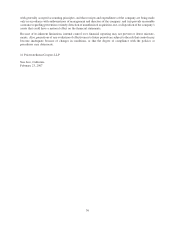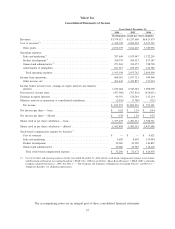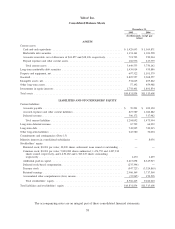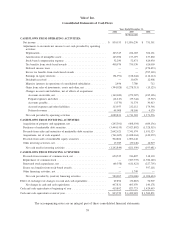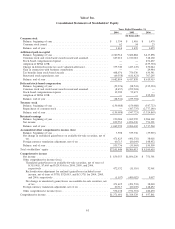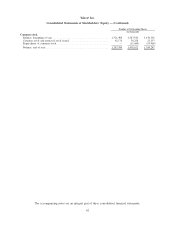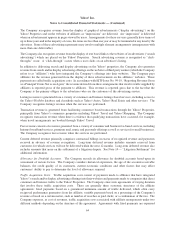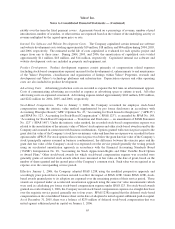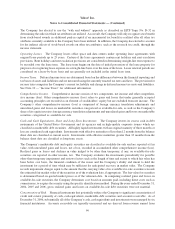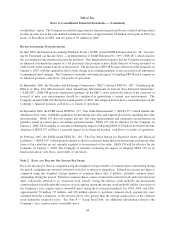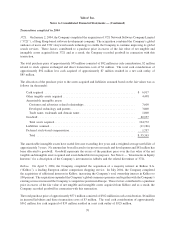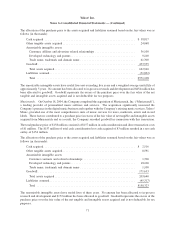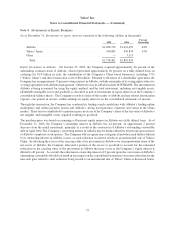Yahoo 2006 Annual Report Download - page 76
Download and view the complete annual report
Please find page 76 of the 2006 Yahoo annual report below. You can navigate through the pages in the report by either clicking on the pages listed below, or by using the keyword search tool below to find specific information within the annual report.The Company has elected to use the “with and without” approach as described in EITF Topic No. D-32 in
determining the order in which tax attributes are utilized. As a result, the Company will only recognize a tax benefit
from stock-based awards in additional paid-in capital if an incremental tax benefit is realized after all other tax
attributes currently available to the Company have been utilized. In addition, the Company has elected to account
for the indirect effects of stock-based awards on other tax attributes, such as the research tax credit, through the
income statement.
Operating Leases. The Company leases office space and data centers under operating lease agreements with
original lease periods up to 23 years. Certain of the lease agreements contain rent holidays and rent escalation
provisions. Rent holidays and rent escalation provisions are considered in determining straight-line rent expense to
be recorded over the lease term. The lease term begins on the date of initial possession of the lease property for
purposes of recognizing lease expense on a straight-line basis over the term of the lease. Lease renewal periods are
considered on a lease-by-lease basis and are generally not included in the initial lease term.
Income Taxes. Deferred income taxes are determined based on the differences between the financial reporting and
tax bases of assets and liabilities and are measured using the currently enacted tax rates and laws. The provision for
income taxes comprises the Company’s current tax liability and change in deferred income tax assets and liabilities.
See Note 10 — “Income Taxes” for additional information.
Comprehensive Income. Comprehensive income consists of two components, net income and other comprehen-
sive income (loss). Other comprehensive income (loss) refers to gains and losses that under generally accepted
accounting principles are recorded as an element of stockholders’ equity but are excluded from net income. The
Company’s other comprehensive income (loss) is comprised of foreign currency translation adjustments and
unrealized gains and losses on marketable securities categorized as available-for-sale, as well as the Company’s
share of its equity investees foreign currency translation adjustments and unrealized gains and losses on marketable
securities categorized as available-for sale.
Cash and Cash Equivalents, Short and Long-Term Investments. The Company invests its excess cash in debt
instruments of the United States Government and its agencies and in high-quality corporate issuers which are
classified as marketable debt securities. All highly liquid investments with an original maturity of three months or
less are considered cash equivalents. Investments with effective maturities of less than 12 months from the balance
sheet date are classified as current assets. Investments with effective maturities greater than 12 months from the
balance sheet date are classified as long-term assets.
The Company’s marketable debt and equity securities are classified as available-for-sale and are reported at fair
value, with unrealized gains and losses, net of tax, recorded in accumulated other comprehensive income (loss).
Realized gains or losses and declines in value judged to be other than temporary, if any, on available-for-sale
securities are reported in other income, net. The Company evaluates the investments periodically for possible
other-than-temporary impairment and reviews factors such as the length of time and extent to which fair value has
been below cost basis, the financial condition of the issuer and the Company’s ability and intent to hold the
investment for a period of time which may be sufficient for anticipated recovery in market value. The Company
records impairment charges equal to the amount that the carrying value of its available-for-sale securities exceeds
the estimated fair market value of the securities as of the evaluation date, if appropriate. The fair value for securities
is determined based on quoted market prices as of the valuation date. In computing realized gains and losses on
available-for-sale securities, the Company determines cost based on amounts paid, including direct costs such as
commissions, to acquire the security using the specific identification method. During the years ended December 31,
2004, 2005 and 2006, gross realized gains and losses on available-for-sale debt securities were not material.
Concentration of Risk. Financial instruments that potentially subject the Company to significant concentration of
credit risk consist primarily of cash, cash equivalents, marketable debt securities and accounts receivable. As of
December 31, 2006, substantially all of the Company’s cash, cash equivalents and investments were managed by six
financial institutions. Accounts receivable are typically unsecured and are derived from revenue earned from
66
Yahoo! Inc.
Notes to Consolidated Financial Statements — (Continued)


